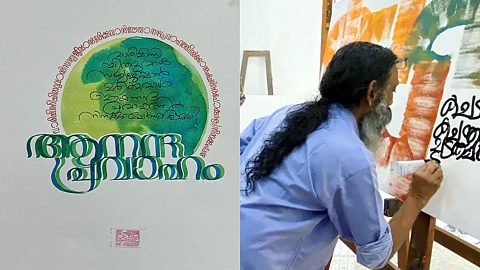
- HOMEGROWN WORLD
- #HGCREATORS
- #HGEXPLORE
- #HGVOICES
- #HGSHOP
- CAREERS
- ABOUT US
- CONTACT US

Who is a pioneer? This is a question that I have thought of time and again and while there are many ways to look at this question, there is one undeniable scenario - someone who is so talented at what they do, that they had a role carved out and created for them in an organisation, because people wanted to give them the title and recognition they deserved. There are perhaps very few people in history who got the honour and Narayana Battathiri is one of those people.
Growing up in a Malayali household with parents who subscribed to umpteen magazines clearly had an impact on me. While I read many of the magazines, I never truly saw Malayalam magazines in their heyday. I remember hearing about them and maybe even seeing a few older magazines in some old suitcase that featured stunning calligraphic headlines in Malayalam that accompanied the features. With a career spanning almost four decades now, Narayana Battathiri was the first person in Kerala to be designated and employed as a calligrapher. His career took shape when became the resident calligrapher at the Malayalam-illustrated weekly news magazine Kalakaumudi.
Even from an early age, the calligrapher had a penchant for the craft. He honed his handwriting skills through the years with relentless practice, slowly starting to take on writing assignments for college magazines and political posters as he started getting older. His passion for calligraphy truly became profound during his time at the College of Fine Arts in Trivandrum where he formally studied painting. In an interview with Times of India, Bhattathiri mentioned how he looks at calligraphy as akin to painting, exploring the exquisite stylisation and expressive qualities of Malayalam letters. He went on to mention how his personal approach towards the art involves using the visual form of Malayalam letters and using it as a medium for creative expression, and focusing on their aesthetic value rather than the literal meaning.
The crucial work done by Narayana Bhattathiri has made a striking impact on the very niche, but integral cultural form of Malayalam calligraphy. There have been papers written about his work by visual art students and he has been the recipient of numerous international awards from the global calligraphy world, most prestigiously the South Korean Jikji prize, particularly after he started sharing more of his work through social media. Funded by the Republic of Korea and established with UNESCO, this Prize is awarded biannually to individuals or institutions that make significant contributions to the preservation and accessibility of heritage.
While he is rightfully getting recognition for his dedicated work in calligraphy, Narayana Bhattathiri noticed the lack of exposure to calligraphy as an art form back home in South India. After an exhibition of his works that featured his many iconic movie titles, feature titles and posters garnered attention, he decided to start Kerala’s first Calligraphy Gallery in Trivandrum. Titled ‘'Ka Cha Ta Tha Pa' (just a string of letters from Malayalam), this space has evolved today to become a space for aspiring calligraphers and enthusiasts of the form alike. While he offers calligraphy classes, Narayana often challenges sustaining student interest and even has to battle misconceptions regarding the scope and benefits of the art form. While Arabic and even Chinese calligraphy are praised and appreciated, there is still an evident need for broader inclusion and better promotion of calligraphy in regional languages.
On a personal note, Narayan Bhattathiri continues his daily practice of waking up to practice calligraphy at 3:00-4:30 AM. In the aforementioned Times of India feature, he mentions how he chooses poetry to practise his art. He went on to say, “I read a lot of poetry and recite them in a low voice when I draw. Reading is the fodder. Without that backing, it is impossible to conjure up new expressions. Similarly, practising is the only way to improve calligraphy skills.”
The artist and his lifelong pursuit of the art form, is paving an avenue towards a future where Malayalam calligraphy is more widely celebrated and integrated into the very cultural fabric of Kerala and the country as a whole.
You can follow him here.
If you enjoyed reading this article, here's more from Homegrown:
How Kerala's 'Lalithakala Akademi' Promotes The Integration Of Art Into Everyday Life
The World's Last Remaining Urdu Calligraphy Newspaper May Soon Be Lost To Us
How Kerala's Ma'din Academy Is Preserving The Ancient Art Of Indian Calligraphy
